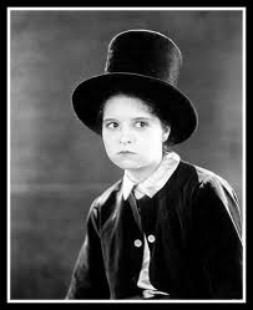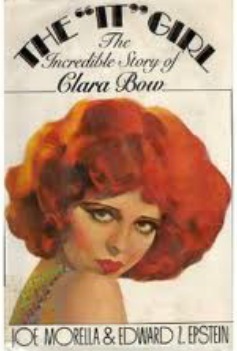Episode 27: Clara Bow
We couldn’t tell the story of Clara Bow entirely in G-rated terms, so younger ears should probably skip this one where we talk about the original It Girl. What is It? Looks, charm, talent, and something special that attracts a wide range of people. It is a mysterious quality usually likened to a form of sex appeal. Clara Bow had It. She used It for her career and It attracted many men. But, in addition to all those marketable qualities that made her a successful silent film star, she had other factors in her life that contrasted: Poverty, abuse, mental illness, and a span of time when she was treated like a pawn in an industry where youth and It survived, and all else was tossed aside.

Clara Gordon Bow was born on July 29, 1905, to Robert and Sara Bow in Brooklyn, New York. We would love to give you a romantic version of her parents, a rags-to-riches love story- but it would be a lie. Robert had a thing for younger girls and liquor; Sara was the daughter of an abusive father and mentally ill mother who was looking for a way out of her home and teen marriage was that ticket.
Robert worked as a singing waiter and at various odd jobs, but he would often leave his wife and child for long stretches. He spent his wages in bars and on underage prostitutes. Sara was miserable at home. Clara was her third child- the first two died almost immediately after birth- and Sara had been advised that another pregnancy might kill both her and the child. Death may have seemed a great strategy for leaving her sad life, but both mother and child survived.
More sadness, and gloom filled the life of young Clara: her mother plummeted through episode after episode of depressed, psychotic and hostile states leaving Clara to take care of both herself and her mother. Clara’s grandfather died at her feet. As a young child she witnessed the gruesome death of her best friend, and she would be forced to drop out of school by seventh grade to get a job to help support her family. We go into details on the podcast of the impoverished and dysfunctional world that Clara grew up in, but let’s suffice it to say, it wasn’t a fairy tale. The escape method that she used was the movies- going to them, reading about them, and dreaming of a life as the person IN the movie magazines, not just reading them.

At the age of 16,she saw her chance in the form of a magazine sponsored contest With a storyline that would make a terrific movie, she scraped together the money for entry pictures, impressed the judges, kicked fanny at the acting auditions and won!Included in the prizes was a photo shoot that created these two images:


Through what may have been the hardest work of his life ( if not a singular moment of support for his child) Robert Bow pushed the powers- that- be to follow through with the other part of the prize: help Clara get work in the movies. Clara got her first role, and- in true movie fashion- her performance ended up on the cutting room floor. Crushing.
But that role landed her the next, and she was off to the glamorous local of….New Bedford, Massachusetts.

In fairly quick order, Clara set off to Hollywood with an agent who had a rather interesting tale to tell after her cross-country train trip with the free spirited, insomniac that was a teenage Clara Bow.
Of course, we go into the whole story on the podcast, but Clara’s acting skills, big eyed beauty, and ability to cry on cue (not to mention her lack of inhibitions and sparkling personality) soon got her the screen time she needed to get her career really started. She signed with Preferred Pictures and let her career be formed in the hands of the head of the studio- B.P. Schulberg.
Her looks and attitude suited the times. Women were taking more risks, making bold moves, bobbing their hair, letting their sexuality shine all while dancing on tables. Well, the women that Clara portrayed on screen were- she personified the flapper, the Jazz Baby. Women wanted to be her, men wanted to be with her and both of them were flocking to her movies.

Throughout the 1920’s Clara was, quite simply, a superstar. Her personal life was as wild as some of the characters she played on the screen. Tooling about town in a roadster she lived her life with as little a filter as she could get away with. (How is that for putting it mildly?) She was romantically linked to many men, and called her own shots in her frenetic personal life. The newspapers and those movie magazines she used to read loved her, although they may have exaggerated some aspects of her life- the public couldn’t get enough of Clara.

The invention of talkie movies slowed Clara down a bit, but it didn’t end her career as is often rumored. What did end it? Maybe the pace she had kept for so long. Maybe a series of ill-timed life moves including several stints in hospitals for “rest” and a much publicized legal battle with a former personal secretary who attempted to blackmail Clara. Maybe the love of a good man, Rex Bell, who helped stabilize her life and gave her the family and normalcy that she had longed for since she was a child. Maybe the times, as the Depression began the flamboyant lifestyle of the now matured flapper wasn’t the image that movie goers craved. Maybe it was a combination of all of those things.
Clara stopped making movies in 1933. She retired to the ranch in Nevada where she and Rex raised two boys. They later divorced and she moved to Los Angeles. She was mostly a recluse, although she did still answer her fan mail and was often surprised when people remembered her. She died of a heart attack in her home on September 27, 1965 at the age of 60.

TIME TRAVEL WITH THE HISTORY CHICKS
First thing we would do? Watch some movies. Netflix streams It, as well as some others, and you can see bits and pieces on YouTube. If you have 7 minutes, give this one a peek… the IT of Clara Bow is very obvious in this clip. This link will take you to a channel with more Clara Bow movie clips.
Since we are talking internet links here, Clara Bow Archive on tumblr maintains a twitter account as well. Get unique pictures of Clara sent right to your twitter feed. Also The Flapper Factor on tumblr is not Clara specific, nor is this Silent Ladies.com , but you might be impressed with the collections presented.
Learning more about a movie star just seems to fit visual media, you know? There is a Biography: Clara Bow which isn’t on Netflix, Hulu or Amazon-but you might want to check out your library.
Turner Classic Movies has a Clara Bow documentary, Discovering the It Girl (narrated by Courtney Love) which we liked. And a related one, Complicated Women: Sex and Power in Pre-Code Hollywood which is narrated by Jane Fonda ( and based on a book by Mick LaSalle who is interviewed in the film). Keep an eye out for airings of both these on TCM, or see if your library has them.
As it ties into this topic, and to cleanse your brain of the Debbie Reynolds Molly Brown image- go see Singing in the Rain. Set in the times of Clara Bow and with some of the (highly Hollywoodized) issues that Clara had to deal with. (Just an aside: the songs were written before the story of this movie but it’s still a fun romp).

We teased you about this in the podcast, an interview by Mark Twain with Elinor Glyn, writer of It and overall character herself.
So you like books? Us toooo! For Clara we recommend:
Clara Bow: Running Wild by, David Stenn



The “It”: Girl: the Incredible Story of Clara Bow by, Joe Morella & Edward EpsteinSilent Stars by Jeanine BasingerAnd finally, as a related recommended read (yes, there is a movie also), A Tree Grows in Brooklyn, by Betty Smith.
As always, music comes courtesy of Music Alley. Visit them at Music.mevio.com


